
Tallships, Tugs & Trawlers: Model Ships
Tallships
Pages
"Firing a Royal Salute" - Ships of the Canadian NavyTallshipsCommercial VesselsShips in a Bottle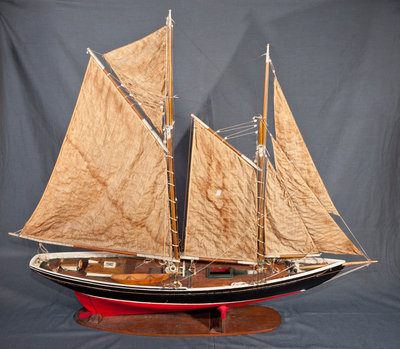
Bluenose I Details
A model of the “Bluenose I” schooner which was originally built in Nova Scotia in 1921. The model was made by Ken Shepherd who came from Nova Scotia to find work in Welland during the 1930’s. It is carved from a single block of wood. This model was purchased by H.H. Hilder, a furniture dealer from Welland. The Hilders would sail the model back and forth across the canal near the downtown Welland bridge.

Bluenose II Details
The original “Bluenose” was captained by Angus Walters and sailed in a series of schooner races, beating the “Elsie” in 1921, the “Henry Ford” in 1922 and the “Gertrude L. Thebuad” in 1923, all American vessels from the famous Glouster shipyards near Boston. Her final race in 1938 was another victory over the “Gertrude” but the “Bluenose” came to an ignoble end after being converted to a freighter and running aground off the coast of Haiti in 1946. The “Bluenose” was modelled after the Baltimore clippers, designed for both safety and speed, allowing their crews to bring in their catches early for the best price. The “Bluenose II,” is a reproduction of the original, and was christened in 1967 in honour of the Centennial celebrations. It is still moored in Halifax harbour today. This model is made of brightly painted wood, has a Canadian dime attached to its first mast, and all of the provincial and territorial flags flying off the second. It was made by Ted Koszucki in 1990.

Gracie May Details
A model of a fishing ship. Commercial fishing began in the 1880s on the Great Lakes. Catches increased with the invention of more modern fishing equipment, but the golden days of commercial fishing were over by the late 1950s. The model was made by Richard Gosse.
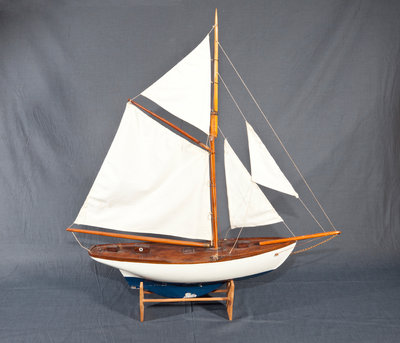
Fishing Sloop Details
Made in 1918 by a retired sailor at Sailors Snug Harbour, a home for retired sailors in Staten Island, N.Y., this model was donated by Mr. and Mrs. J. Walter.
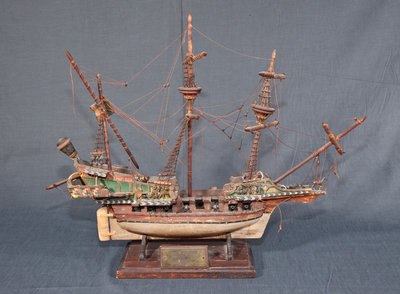
Golden Hind Details
The “Golden Hind” was sailed by Francis Drake during a voyage that lasted from 1577-1580 and would make him the first Englishman to circumnavigate the globe. She was originally named “Pelican” but Sir Francis Drake renamed her mid-voyage in 1577. After the completion of the voyage, Queen Elizabeth I knighted Drake on deck.
This ship model was built by Hugh Hasiltine during World War II while serving on a destroyer during one of the Murmansk Convoys to Russia. The brass plaque attached to the base reads “Golden Hind – 16th Century – Captain Sir Francis Drake.” The model and base are made of wood, and brown string was used for the rigging. The model is hand-painted, and the flag attached to the rigging at the stern is cardboard.
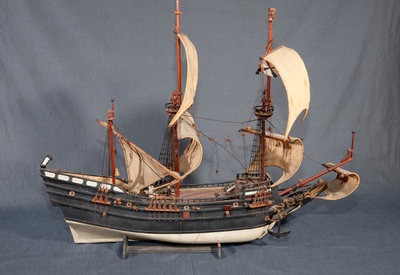
Halvemaen Details
The “Halvemaen” was a ship of the Dutch East India Company, commissioned by the Dutch Republic in order to find an eastern passage to China, and was captained by Henry Hudson. Two replicas of this ship have been built, the first in 1909 by the Kingdom of the Netherlands, and the second in 1989 in Albany, New York. This model was handcrafted out of wood c. 1900.
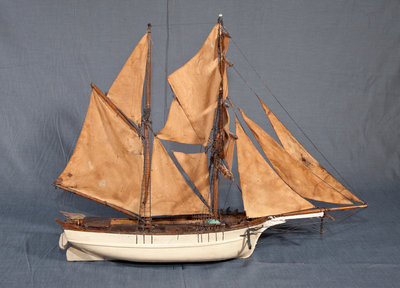
Seagull of Oakville Details
This model is a representation of a schooner that sailed on the Great Lakes. Schooners have been in use for centuries having being first developed by the Dutch in the 16th or 17th century, and then being further refined in North America since the early 18th century.
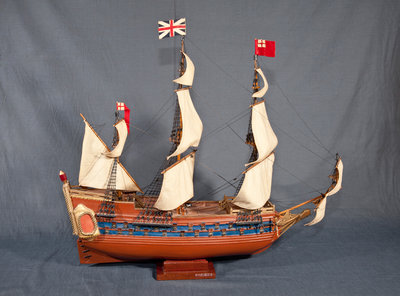
Sovereign of the Seas Details
The “Sovereign of the Seas” was a 90-gun First Rate ship of the line of the English Royal Navy. It was built by Charles I in 1635 in order to bolster the reputation of the English crown, and was completely destroyed in an accidental fire in 1697. This replica of “Sovereign of the Seas” was built by Harry Nixey from a kit.
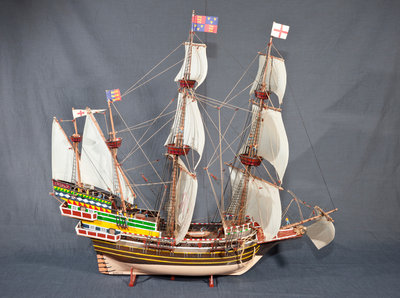
English Man O'War Details
A model of an English Man O’ War, a type of armed vessel which could carry up to 124 guns. It was first developed in England during the 17th century. The model was constructed in 1986 from a kit by Charles Conner. The four flags are made of paper, the rigging is made of string, and the remainder of the ship is made of plastic. The small figures of the crew as well as the ship are both hand-painted.
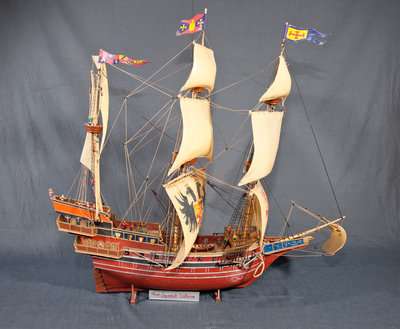
Spanish Galleon Details
A model of a 16th Century Spanish Galleon, a multi-decked sailing ship used for both war and trade. The model was constructed from a kit in 1986 by Charles Conner. The three flags are made of paper, the rigging and anchor rope is made of string, and the remainder of the ship is made of plastic. The small figures of the crew as well as the ship are both hand-painted.

The "Mary" Details
This model originally belonged to the Merritt family, farmers at Attercliff, near Dunnville. The model was kept on the mantelpiece at the farm.
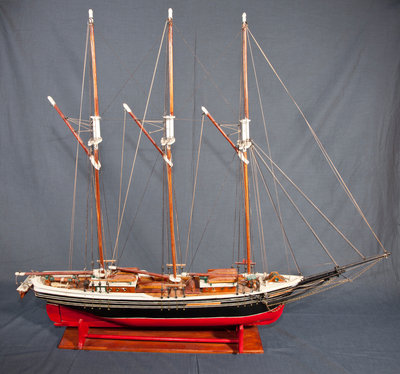
Gaspe Trader Details
A model of the wooden auxiliary schooner the “Gaspe Trader” which was originally built in 1918 by H.A. Ellis of Barachois, Quebec. Auxiliary sailing vessels are ships primarily powered by sail but also have engines which can be used when needed.
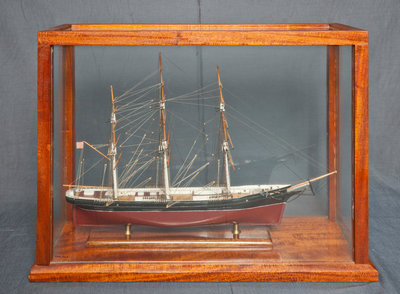
Clipper Ship Details
Clippers were fast sailing ships of the 19th century. They were generally quite narrow and built mostly in British and American shipyards. They weren’t well suited to carry large amounts of freight and were therefore primarily used for the transportation of low-volume, high-profit goods such as tea. This model of a Clipper was built by Capt. J.W. Sharpe in 1945-1946 and is in a mahogany and glass case.
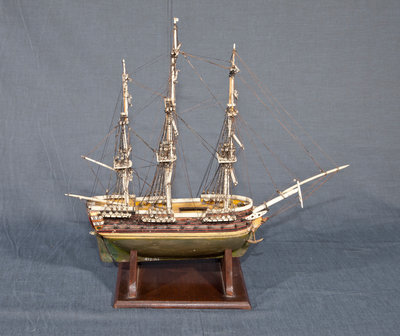
Bone Model Details
This model was donated by Miss Erie Carter. It had originally belonged to her father DeWitt Carter who bought it second hand and had it restored c.1900. It is a model of a warship that was constructed of bone by a French prisoner-of-war during the Napoleonic Wars. Bone models were made in many different prisons during this period. Mutton bones that came from the prisoners’ meals’ were often used in the ships construction; however the bones of deceased prisoners called “Dieppe Ivory” were occasionally used as well. It has been suggested that the models were often the work of syndicates whose members collaborated, each prisoner contributing a particular skill to one feature of the model. They were made not only to while away the tedium of captivity but to make money with which food and comforts could be purchased. Different methods were used in the construction of the models. Sometimes the hull was shaped from a single bone, but more often the models were ribbed and planked like real vessels, with tiny nails inserted to hold the frame together. Human hair was often used for the rigging, as well as horsehair and silk. The scale of these models is not always accurate, as the modellers had to work by eye. The decoration of the ships is often excessive, but the result is a delightful work of art, achieved by craftsmen. In fact, bone models became so popular that they continued to be made after the end of the Napoleonic Wars in 1815. Models exist of ships which were not launched until 1820 or 1825.
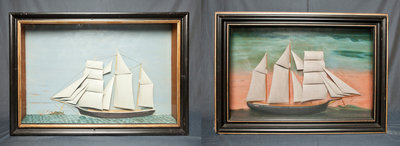
Sun Rise & Sun Set Shadowboxes Details
This pair of shadowboxes depict the sailing ships the “Sun Rise” & the “Sun Set”. They underwent conservation treatment by conservators at the Ministry of Citizenship & Culture Conservation Facilities in 1985. These shadowboxes were donated by Miss Erie Carter, who was the daughter of DeWitt Carter.
